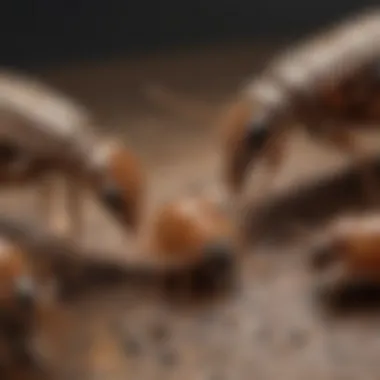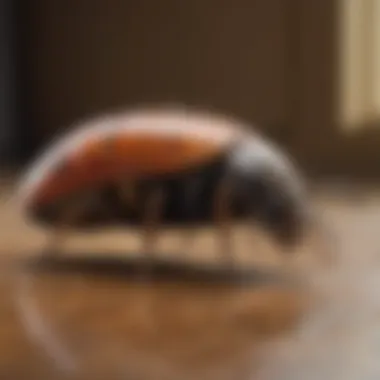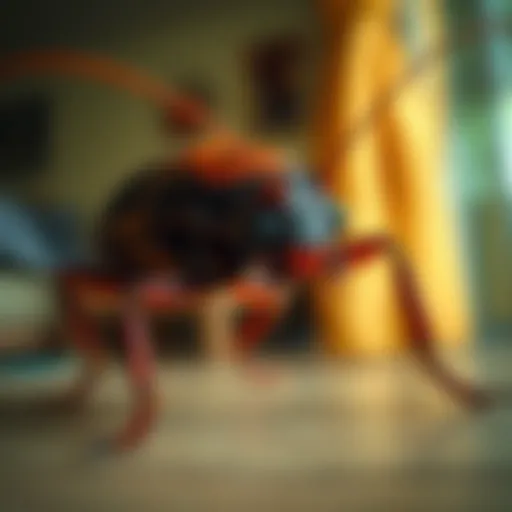Understanding Esco Termite & Pest Control Solutions


Intro
Pest management is a vital aspect of home maintenance. Not only does it protect property, but it also ensures a safe, healthy living environment. Esco Termite & Pest Control has placed itself at the forefront of pest control solutions, offering methods that address pest issues effectively and sustainably. Understanding the nature of pests, their identification, and preventive measures can make a significant difference in managing infestations and reducing reliance on chemical treatments.
Understanding Pests
Definition of Pests
Pests are organisms that can harm human health, property, or the environment. These can include insects, rodents, and other wildlife. They often invade homes and gardens, seeking food, shelter, or breeding grounds. Some common household pests include termites, ants, spiders, and rodents.
Importance of Pest Identification
Identifying pests accurately is crucial for effective management. Each type of pest requires specific treatments and management strategies. Misidentification can lead to ineffective treatment and potential damage to property or health. Effective pest identification involves observing the pest's physical characteristics and behaviors, which can guide the selection of appropriate control methods.
"Accurate pest identification paves the way for successful control solutions."
Prevention Techniques
Home and Garden Preventative Measures
Preventing pest infestations begins at home. Simple adjustments can create a less inviting environment for pests. Here are some effective measures:
- Sealing Entry Points: Caulk gaps and cracks in walls, windows, and doors.
- Proper Waste Management: Store food in airtight containers and properly dispose of garbage.
- Yard Maintenance: Keep vegetation trimmed and remove standing water to discourage breeding.
Seasonal Prevention Tips
The seasons influence pest behavior. Therefore, seasonal precautions are necessary:
- Spring: Inspect for early signs of termites. Maintain mulch levels away from foundations.
- Summer: Monitor for ants and wasps as activity peaks.
- Fall: Seal exterior areas to prevent pests from invading for warmth.
- Winter: Check for signs of rodent activity indoors.
Eco-Friendly Pest Control Solutions
Overview of Sustainable Practices
Esco Termite & Pest Control emphasizes eco-friendly practices that minimize chemical usage. Integrated pest management (IPM) adopts a comprehensive approach combining various strategies such as biological control, habitat manipulation, and cultural practices. This not only mitigates immediate pest issues but also promotes long-term prevention.
Natural Remedies and Their Effectiveness
Natural remedies can serve as an alternative to chemical treatments. Some examples include:
- Diatomaceous Earth: A natural pesticide that is effective against insects.
- Essential Oils: Oils like peppermint and tea tree can repel certain pests.
- Boric Acid: A natural compound used to control pests like cockroaches and ants.
While natural remedies can be effective, their applications and success rates may vary. Combining them with other methods often yields the best results.
Through understanding Esco’s approaches and the broader context of pest management, property owners can better defend their homes against pests. The commitment to both environmentally friendly practices and effective strategies underscores the importance of integrated pest control. For more information, consider exploring additional resources like Wikipedia, Britannica, Reddit, or Facebook.
Overview of Esco Termite & Pest Control
The "Overview of Esco Termite & Pest Control" section serves as a foundational understanding of the company’s mission and offerings. When addressing pest management, it is important to recognize the specialized approaches adopted by Esco. This would provide insights not only into their philosophy but also the comprehensive range of services available to homeowners. This section highlights the necessity for effective pest control as not all methods yield equal results.
Company History and Philosophy
Esco Termite & Pest Control has built its reputation over many years, emerging as a leader in pest management. The company originated from a desire to provide reliable pest solutions that prioritize customer satisfaction and ecological integrity. As such, business practices are influenced by a sense of responsibility towards the environment. This philosophy emphasizes the balance between effective pest control strategies and sustainable practices. Esco understands that pest management is not a one-time event but rather an ongoing commitment to safeguarding homes and properties from unwanted guests.
Core Services Offered
Esco Termite & Pest Control offers a variety of services tailored to address the needs of their clients. These services are designed to manage both common and complex pest issues.
- Termite Control: Focused strategies aim to detect termites early and mitigate damage to properties.
- General Pest Control: Broad services that include treatment for ants, roaches, spiders, and rodents.
- Bed Bug Solutions: Targeted approaches to deal specifically with bed bugs, ensuring thorough eradication.
- Preventive Services: Solutions aimed at preventing pest infestations before they occur, through regular inspections and maintenance.
The comprehensive nature of these services allows for customized plans that cater directly to the specific needs of each property, ensuring effectiveness and peace of mind for homeowners.
Understanding Common Pests
Understanding common pests is a critical aspect of effective pest management, especially in the context of Esco Termite & Pest Control. Recognizing these pests promptly helps homeowners mitigate potential harm before infestations escalate. This section will focus on the significance of identifying termites and other prevalent pests.
Identification of Termites


Termites are often referred to as the "silent destroyers" due to their ability to cause significant damage to wooden structures without immediate detection. Their presence can be detrimental to the integrity of a building, rendering quick identification essential. Homeowners should be aware of the signs indicating a termite problem. Some indicators include:
- Mud tubes: These pencil-sized, tan tubes are structures built by termites to protect themselves from open air while traveling between their colony and a food source.
- Damaged wood: Termites consume wood from the inside out, leading to hollowed or damaged areas. Tapping on wooden surfaces may reveal a hollow sound.
- Swarms: Reproductive termites, known as alates, swarm in the spring to form new colonies. Finding these swarms inside or near a home is a strong signal of an existing infestation.
Understanding these indicators empowers homeowners to take prompt action. Frequent inspections of the home, particularly in areas with high moisture, can help in identifying problems early, which can be crucial in preventing extensive damage.
Recognizing Other Common Pests
While termites pose a significant threat, other pests also deserve attention. Different pests have unique signs and behaviors to watch for. Here are a few common pests and their identifying features:
- Ants: They are often seen trailing in lines. Look for small mounds or openings where they may be nesting.
- Rodents: Signs of rodent infestations may include droppings, gnawing marks, and nests made from shredded paper or fabrics.
- Cockroaches: These pests are nocturnal and often leave behind feces that resemble black pepper. Their egg cases may be found in hidden corners.
- Bedbugs: Look for small, dark spots on bedding or signs of bites on the body. They are often hard to spot due to their ability to hide well.
Being vigilant about these signs can make a tangible difference. Homeowners should keep their surroundings clean, sealing cracks and crevices, which can minimize potential entry points for pests.
"Preventive measures, such as regular inspections and good sanitation, play a critical role in maintaining a pest-free home environment."
The understanding of common pests not only aids in quick diagnosis but also highlights the importance of preventative approaches. By recognizing the traits of these pests, homeowners can significantly reduce the likelihood of infestation and related damage.
The Importance of Pest Control
Pest control is not only a matter of aesthetics but also essential for health and economic stability. Understanding its significance offers insights into both preventative measures and the necessity for ongoing management strategies. This section delves into the health implications of pest infestations and the economic impact those pests can have on homes and businesses alike.
Health Implications of Infestations
Pests are carriers of various diseases that pose a risk to human health. For instance, rodents can transmit hantavirus and leptospirosis. Insects such as mosquitoes are notorious for spreading diseases like malaria and West Nile virus. The presence of these pests can lead to significant health issues for households, especially those with vulnerable members, such as children and the elderly.
Beyond infections, pests can also cause allergic reactions. Cockroaches, for example, leave behind droppings and shed skin, both of which can trigger asthma attacks and other allergic responses. Therefore, keeping an eye on pest populations can help maintain a healthy living environment.
Regular pest control measures, combined with hygiene practices, can greatly reduce these health risks. Ensuring that the living conditions are unfavorable for pests is key. It is critical to seal entry points and maintain cleanliness, as these actions serve to minimize the chances of pest infestations and thus reduce potential health hazards.
Economic Impact of Pest Damage
Pests also exert a considerable economic toll on property owners. Termites alone cause billions of dollars in damage each year in the United States. These wood-destroying insects can compromise the structural integrity of homes, leading to costly repairs. Beyond termites, other pests like rodents can chew through insulation, wiring, and other building materials, incurring further expenses.
The economic implications extend beyond direct damage. Businesses faced with pest infestations risk reputational damage, loss of customers, and potential legal actions. A restaurant, for example, may face closure due to health department violations stemming from pest problems, leading to a sharp decline in revenue.
To mitigate these economic risks, it's advisable to invest in regular pest control services. Homeowners and business operators can save money in the long run by addressing pest issues promptly and preventing larger infestations.
In summary, effective pest control is crucial for protecting health and minimizing economic losses. The necessity of ongoing vigilance cannot be overstated as it contributes to a pest-free environment that supports well-being and financial stability.
Maintaining awareness about the implications of pest management ensures not only residential safety but also fosters informed decisions regarding overall property maintenance. A proactive stance towards pest control is beneficial and serves community health interests.
Prevention Techniques
Pest prevention is a critical aspect of maintaining a safe and healthy living environment. With the right techniques, homeowners can effectively reduce the risk of infestations before they begin. Understanding prevention techniques not only saves money on costly treatments but also contributes to the overall well-being of households. Here, we will discuss two vital areas of focus: home maintenance practices and landscape management.
Home Maintenance Practices
Regular home maintenance is crucial for preventing pest infestations. First, sealing up potential entry points can significantly reduce the chances of pests making their way inside. Small gaps, cracks in walls, and holes around windows and doors should be caulked or filled. Furthermore, ensuring that screens on doors and windows are intact can keep out various flying insects.
In addition, it is essential to keep the home clean. Food crumbs on floors or countertops provide a welcoming habitat for pests. Regularly cleaning areas such as kitchens and dining spaces, as well as promptly addressing spills and food waste, will help deter pests.
"A clean home is the first line of defense against unwanted pests."
Moreover, proper storage of food is important. Items should be stored in durable containers that are sealed tight. Not only does this protect food from pests, but it also reduces exposure to moisture that can attract them. Another consideration is regular waste disposal. Garbage should be taken out frequently, and bins should be kept covered and cleaned routinely to prevent attractants from accumulating.
Landscape Management for Pest Control
Effective pest control extends beyond the home and into the landscape surrounding it. One of the first steps is to maintain a well-kept yard. Overgrown vegetation provides hiding spots for pests. Regular trimming of bushes and trees, as well as mowing the lawn, helps restrict the environment that pests prefer.
Another element in landscape management is proper drainage. Standing water can attract mosquitoes, which thrive in those conditions. Ensuring that gutters are clear and landscape is designed to facilitate proper drainage will reduce water accumulation. Furthermore, any excess yard debris should be cleared away, as piles of leaves or garden waste can attract both pests and rodents.
Plant selection also plays a role. Homeowners can opt for pest-repelling plants like marigolds and lavender, which can deter specific insects naturally. Integrating companion planting into garden design can also enhance pest resistance.
Ultimately, thoughtful landscape management not only beautifies the yard but also sets up natural barriers against infestations. Incorporating these practices into regular home and garden care is key to maintaining a pest-free environment.
Treatment Strategies
Treatment strategies play a vital role in pest management by providing systematic approaches to mitigate pest infestations. They encompass various methods and techniques that address both the immediate concerns caused by pests and the long-term solutions that prevent future occurrences. Understanding these strategies is crucial for homeowners, as it aids in selecting the most effective methods suited to their specific pest problems.


Conventional Pest Control Methods
Conventional pest control methods have been widely used for many years. These methods typically involve the application of chemical pesticides intended to eliminate pests quickly. Common techniques include:
- Spraying pesticides in areas where pests are frequently seen.
- Fumigation for larger infestations, particularly for termites or bed bugs.
- Baiting systems that attract pests and, when ingested, lead to their elimination.
While conventional methods can be effective, they also carry some risks, such as potential harm to beneficial insects and the environment. Homeowners should consult with professionals to ensure the correct applications and dosages are used to minimize these risks.
Integrated Pest Management
Integrated Pest Management (IPM) is a more holistic approach. IPM combines various management strategies while emphasizing prevention and monitoring. The key elements of IPM include:
- Regular inspections to assess pest presence and population levels.
- Identifying the pest's life cycle for better timing of treatments.
- Using a mix of methods, including biological controls, habitat manipulation, and chemical treatments, to achieve sustainable results.
IPM encourages homeowners to adopt practices that do not rely completely on chemical solutions. This method reduces potential side effects, promotes a healthy environment, and effectively controls pests over time.
Eco-Friendly Solutions and Alternatives
Eco-friendly solutions are increasingly important in modern pest control. These alternatives aim to minimize chemical usage, thereby reducing environmental impact. Some of the eco-friendly options include:
- Biological control, where natural predators or parasites are used to manage pest populations.
- Botanical insecticides derived from plants, which can be less harmful than synthetic chemicals.
- Physical barriers, such as using nets or traps, to prevent pest entry.
Implementing eco-friendly practices not only protects the environment but also improves the safety of living spaces for families and pets. Homeowners are encouraged to consider these methods when devising their pest management plans.
"The goal of effective pest management should be to maintain an effective balance between pest control and environmental health."
Technology in Pest Control
In the modern era, the integration of technology into pest control has become crucial. Precision and efficiency are two major benefits brought about by advancements in this field. As pests evolve and adapt, traditional methods may become less effective. Therefore, employing innovative technologies for detecting and treating infestations is increasingly important.
Advancements in Pest Detection
The first line of defense against pests lies in their detection. Advancements in pest detection have provided operators with new tools to identify infestations more accurately and efficiently. One significant development is the use of thermal imaging cameras. These devices allow professionals to locate infestations by detecting heat generated by pests, especially termites, hidden in walls or insulation.
Another promising innovation is the application of remote sensing technology. This can include the use of smart sensors that monitor pest activity in real-time, sending alerts when specific parameters indicate an infestation. Integrating these technologies helps service providers react promptly to pest issues before they escalate into larger problems.
Additionally, drones are being utilized for expansive property inspections. They can cover large areas quickly and inspect hard-to-reach locations, identifying any signs of pest activity.
"Emerging technologies are redefining the landscape of pest management, empowering professionals with the tools they need to safeguard homes effectively."
Innovations in Treatment Applications
Following the detection of pests, it is critical to have effective treatment solutions. Innovations in treatment applications have transformed how pest control services operate. One noteworthy method is the use of micro-encapsulation technology. This allows pesticides to be encapsulated in a protective coating, releasing the active ingredient gradually. This ensures a longer-lasting effect while minimizing environmental impact.
Furthermore, advancements in biopesticides are noteworthy. These products utilize naturally occurring substances to control pests. They are less harmful to beneficial insects and pose fewer risks to people and pets, aligning with the growing demand for eco-friendly solutions in pest management.
Moreover, automated application systems have gained popularity. These systems deliver precise dosages of treatment materials, reducing waste and enhancing effectiveness. Such precision not only improves the outcomes but also enhances safety and compliance with regulations.
The Role of Professionals in Pest Management
In the realm of pest control, the role of professionals cannot be overstated. Engaging skilled technicians from Esco Termite & Pest Control brings numerous advantages. These experts possess the knowledge and experience necessary to identify specific pest issues, understand their behavior, and determine appropriate treatment strategies. They operate under rigorous guidelines, ensuring that problem-solving approaches are not only effective but also compliant with legal and safety standards.
Professionals also play a critical role in leveraging advanced technology. They use tools and solutions that are often inaccessible to the average homeowner. For instance, thermal imaging can detect infestations within walls without invasive procedures. The knowledge of these professionals helps in making informed decisions that can lead to long-term pest management solutions.
Additionally, professionals are trained to assess the different types of products available. They can discern which are suitable for specific environments, considering both client needs and environmental impact. This highlights the complexity of pest control—it's not enough to apply a one-size-fits-all solution.
"A DIY approach might seem appealing, but the reality is that professional pest control often saves time and reduces risks."
They can ensure that your home is not only pest-free but also safe for children and pets, choosing eco-friendly treatments when necessary. Their expertise allows them to establish preventive measures, thus minimizing future infestations.
When to Call Exterminators
Recognizing when to involve a pest control professional is a key skill for homeowners. If you notice signs of infestations such as droppings, gnaw marks, or damaged wood, it is crucial to act promptly. Termites, for example, can silently damage wooden structures, leading to costly repairs if not addressed in time.
Consider scheduling an assessment when:
- You see repeated pest activity, indicating that DIY solutions are ineffective.
- Structural damage becomes apparent; this can be a sign of serious infestation.
- If allergic reactions in household members occur, it is vital to investigate.
Waiting too long can exacerbate problems, making pest control more complicated and expensive. Regular inspections and maintenance might prevent issues by catching them early. Always err on the side of caution and consult a professional when in doubt.


Evaluating Service Providers
Choosing the right pest control service is essential. The effectiveness of pest management depends heavily on the provider's expertise and reputation. When evaluating service providers like Esco, here are factors to consider:
- Certifications and Licenses: Confirm that the provider is licensed and certified to operate in your state. This assures you that they adhere to legal standards.
- Experience and Reputation: Research the company's history and customer feedback. Online reviews and testimonials can provide insights into their success rate and customer service.
- Integrated Pest Management (IPM) Practices: Inquire whether they use IPM techniques. This approach focuses on long-term prevention and minimizes risks to health and the environment.
- Transparency in Pricing: A reliable service provider should offer clear pricing structures without hidden fees. Understanding what you pay for helps manage expectations.
- Customer Support: Evaluate their customer service responsiveness. Good communication is vital for addressing any concerns you may have.
When selecting a pest control provider, a well-informed choice can lead to successful and sustainable pest management. Take the time to assess your options carefully.
Legal and Safety Considerations
When dealing with pest control, understanding the legal and safety considerations is crucial. This aspect not only safeguards homeowners and professionals but also ensures compliance with regulations that govern pest management. Inadequate knowledge can lead to legal repercussions and safety hazards, making it essential for homeowners to be informed.
Regulations on Pest Control Practices
Regulations concerning pest control practices vary by region but generally aim to protect public health and the environment. These regulations often dictate the types of pesticides allowed, methods of application, and safety protocols that must be observed. Here are significant points to consider:
- Licensing and Certification: Pest control operators must hold relevant licenses and certifications. This ensures that they are trained to handle pesticides and understand the legal statutes that govern their use. Homeowners should always request proof of certification before hiring a professional.
- Environmental Protection: There are strict laws in place to protect wildlife and biodiversity. Certain chemicals may be banned or restricted due to their potential environmental impacts. Understanding these regulations can help homeowners select safe and compliant pest control solutions.
- Notification Requirements: Some jurisdictions require that property owners notify occupants about pesticide applications. This is particularly important in multi-unit buildings. Homeowners must comply with such regulations to ensure the safety of all residents.
"Regulations are not just red tape; they serve to protect both people and the environment."
Safety Protocols in Pest Treatment
Safety protocols during pest treatment ensure the well-being of homeowners, pets, and the environment. These protocols can vary based on the type of treatment, but common practices include:
- Proper Use of Protective Gear: Pest control professionals should use appropriate personal protective equipment (PPE) such as gloves, masks, and goggles. Homeowners should also be cautious and maintain a distance during treatment procedures.
- Adherence to Label Instructions: All pesticides come with specific instructions regarding application rates and safety measures. It is vital that both professionals and homeowners strictly adhere to these guidelines to minimize health risks.
- Post-Treatment Precautions: After treatment, there are often recommendations for how long to stay away from treated areas. Homeowners should follow these recommendations closely to prevent exposure to any harmful chemicals.
- Emergency Procedures: It’s essential for service providers to have emergency procedures in place in case of accidental exposure or spills. Homeowners should also be informed about first aid measures and whom to contact in case of emergencies.
Understanding these legal guidelines and safety protocols helps maintain a safe pest control environment while ensuring compliance with regulations. Being informed not only protects individuals but also fosters a balanced approach to pest management.
Long-term Pest Management Solutions
Long-term pest management solutions play a crucial role in establishing and maintaining a pest-free environment, particularly for residential spaces. These solutions extend beyond mere eradication of pests; they focus on prevention, monitoring, and education, creating a sustainable approach to pest control. The benefits of such strategies are manifold, as they not only address current pest issues but also help in mitigating future infestations.
Effective management requires a blend of ongoing practices and community involvement, making it a shared responsibility. Employing long-term strategies keeps pest populations in check while minimizing reliance on chemical treatments. This is especially important for households concerned about the ecological footprint of their pest control efforts.
Ongoing Monitoring and Maintenance
Ongoing monitoring and maintenance form the backbone of effective long-term pest management. Regular inspections can help identify potential pest problems before they escalate into significant infestations. Homeowners should consider implementing a schedule for monthly or quarterly check-ups by professionals. This ensures that any changes in pest activity are promptly addressed.
Homeowners can also engage in self-monitoring. This means being vigilant about signs of infestations, such as droppings or structural damage. For instance, if a termite infestation is suspected, areas near wooden structures should be closely observed for any signs of damage.
Regular maintenance practices, such as sealing entry points and maintaining clean environments, contribute significantly to controlling pest populations.
Community Awareness and Education
Community awareness and education are integral components of long-term pest management solutions. When individuals in a neighborhood are educated about pest control measures, collective efforts can lead to effective control. Communities can participate in workshops or seminars led by pest control professionals. These platforms can promote knowledge sharing about identifying pests, understanding their habits, and discussing preventive measures.
Moreover, local community groups can foster engagement by organizing clean-up drives or landscaping initiatives that discourage pest habitation. This not only benefits individual homes but also enhances the overall living environment.
Ultimately, a well-informed community can lead to a significant reduction in pest-related issues. This approach reinforces the idea that pest management is not solely a homeowner's duty but a community endeavor that requires cooperation and shared responsibility.
"Effective pest management is a shared concern that goes beyond individual homes, emphasizing the importance of community involvement and education."
Combining ongoing maintenance with community education creates a robust strategy for preserving the integrity of homes and maintaining ecological balance.
Culmination
The conclusion of this article on Esco Termite & Pest Control serves several important functions. It encapsulates the key elements discussed throughout, reinforcing the significance of pest control in everyday life. Pest management is not merely a response to infestations; it is a proactive approach that safeguards health, property, and the environment. Understanding various pests, treatment strategies, and preventive measures provides homeowners with the knowledge needed to maintain a pest-free living space.
Summarizing Pest Control Essentials
By revisiting the essential aspects of pest control, this conclusion highlights several core elements:
- Awareness and Identification: Recognizing signs of pest presence is critical for early intervention. Understanding the types of pests common to one's area can help in making informed decisions.
- Proactive Measures: Home maintenance and landscape management are vital. Simple actions like regular inspections and proper sanitation reduce the risk of infestations.
- Professional Involvement: Knowing when to contact Esco or other professionals can prevent small problems from becoming major issues. Their expertise in identifying and treating infestations is invaluable.
- Adopting Eco-Friendly Solutions: As discussed earlier, sustainable practices not only protect the environment but also ensure the safety of residents and pets.
This comprehensive understanding of the essentials empowers households to take charge of their pest management needs effectively.
Future of Pest Management
Looking to the future of pest management, several trends and considerations are noteworthy. The integration of technology into pest control strategies holds promise for more targeted and efficient solutions. Emerging technologies like remote monitoring sensors and data analytics enable homeowners to track pest activities in real-time, allowing for quicker responses.
Additionally, there is a growing emphasis on sustainability. More pest control companies are likely to adopt green practices and eco-friendly treatments as consumer demand for environmentally responsible solutions increases. These approaches not only protect the ecosystem but also foster healthier living conditions.
As the understanding of pest behaviors evolves, integrated pest management will play a greater role. This strategy combines cultural, biological, and chemical control methods, ensuring a comprehensive approach to pest management.
In summary, the future of pest management will continue to focus on innovation and sustainability. Homeowners must stay informed about new developments and maintain a proactive stance toward pest control.

